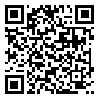Volume 17, Issue 2 (Summer 2025)
2025, 17(2): 9-0 |
Back to browse issues page
Ethics code: IR.UMSHA.REC.1402.041
Download citation:
BibTeX | RIS | EndNote | Medlars | ProCite | Reference Manager | RefWorks
Send citation to:



BibTeX | RIS | EndNote | Medlars | ProCite | Reference Manager | RefWorks
Send citation to:
Zamani M, Khosravi H, Imani B, Najafi Vosoogh R, Abdi A. Assessment of Radiation Dose Received by Orthopedic and Spine Operating Room Personnel during C-Arm Use Using Experimental Methods and Monte Carlo Simulation. North Khorasan University of Medical Sciences 2025; 17 (2) :9-0
URL: http://journal.nkums.ac.ir/article-1-3222-en.html
URL: http://journal.nkums.ac.ir/article-1-3222-en.html
1- MSc Student of Operating Room, Student Research Committee, Hamadan University of Medical Sciences, Hamadan, Iran
2- Associate Professor, Department of Radiology, Faculty of Paramedicine, Hamadan University of Medical Sciences, Hamadan, Iran ,hkhosravi55@gmail.com
3- Associate Professor, Department of Operating Room, Faculty of Paramedicine, Hamadan University of Medical Sciences, Hamadan, Iran
4- Assistant Professor, Health Sciences Research Center, Hamadan University of Medical Sciences, Hamadan, Iran
2- Associate Professor, Department of Radiology, Faculty of Paramedicine, Hamadan University of Medical Sciences, Hamadan, Iran ,
3- Associate Professor, Department of Operating Room, Faculty of Paramedicine, Hamadan University of Medical Sciences, Hamadan, Iran
4- Assistant Professor, Health Sciences Research Center, Hamadan University of Medical Sciences, Hamadan, Iran
Abstract: (6 Views)
Introduction: Due to increasing use of C-arm in surgeries, personnel are exposed to a greater risk of radiation. Accurate assessment of the dose received during various surgeries is one of the most important measures to prevent radiation-related complications. This study aimed to evaluate the dose received by operating room staff in orthopedic and spinal surgeries while using the C-arm device utilizing experimental methods and Monte Carlo simulation.
Method: This cross-sectional study was conducted from September to February 2023. To record the absorbed dose, TLD 100 dosimeters were used, and instead of humans, phantoms were utilized. The dosimeter was placed on the thyroid of the phantom. The phantoms were positioned both behind and in front of a lead wall at three locations: right, center, and left. The C-arm device was used to simulate orthopedic and neurosurgery procedures in both anteroposterior and lateral positions. Data analysis was performed using SPSS software (version 24), with a significance level set at 0.05 for the tests.
Results: The absorbed dose for the phantoms positioned behind the lead wall was significantly lower than that in front of the wall (P<0.05). When the phantom was in front of the wall, it received a higher dose in the lateral position of the C-arm, compared to the anteroposterior position (P<0.05). Additionally, when the phantom was placed behind the lead wall in the center and left positions, it received a higher dose in the anteroposterior position of the C-arm, compared to the lateral position (P<0.05).
Conclusion: The results of this study indicated a significant impact of the C-arm device's position, as well as the use of protective equipment on the dose received by operating room personnel during orthopedic and neurosurgical procedures. It emphasizes the importance of using appropriate shields when working with the C-arm.
Method: This cross-sectional study was conducted from September to February 2023. To record the absorbed dose, TLD 100 dosimeters were used, and instead of humans, phantoms were utilized. The dosimeter was placed on the thyroid of the phantom. The phantoms were positioned both behind and in front of a lead wall at three locations: right, center, and left. The C-arm device was used to simulate orthopedic and neurosurgery procedures in both anteroposterior and lateral positions. Data analysis was performed using SPSS software (version 24), with a significance level set at 0.05 for the tests.
Results: The absorbed dose for the phantoms positioned behind the lead wall was significantly lower than that in front of the wall (P<0.05). When the phantom was in front of the wall, it received a higher dose in the lateral position of the C-arm, compared to the anteroposterior position (P<0.05). Additionally, when the phantom was placed behind the lead wall in the center and left positions, it received a higher dose in the anteroposterior position of the C-arm, compared to the lateral position (P<0.05).
Conclusion: The results of this study indicated a significant impact of the C-arm device's position, as well as the use of protective equipment on the dose received by operating room personnel during orthopedic and neurosurgical procedures. It emphasizes the importance of using appropriate shields when working with the C-arm.
Type of Study: Orginal Research |
Subject:
Basic Sciences
Received: 2024/11/2 | Accepted: 2024/12/31 | Published: 2025/05/29
Received: 2024/11/2 | Accepted: 2024/12/31 | Published: 2025/05/29
Send email to the article author
| Rights and permissions | |
 |
This work is licensed under a Creative Commons Attribution-NonCommercial 4.0 International License. |





